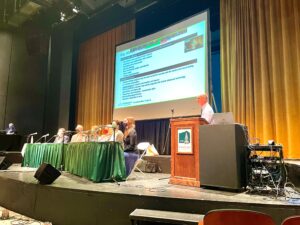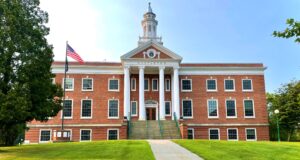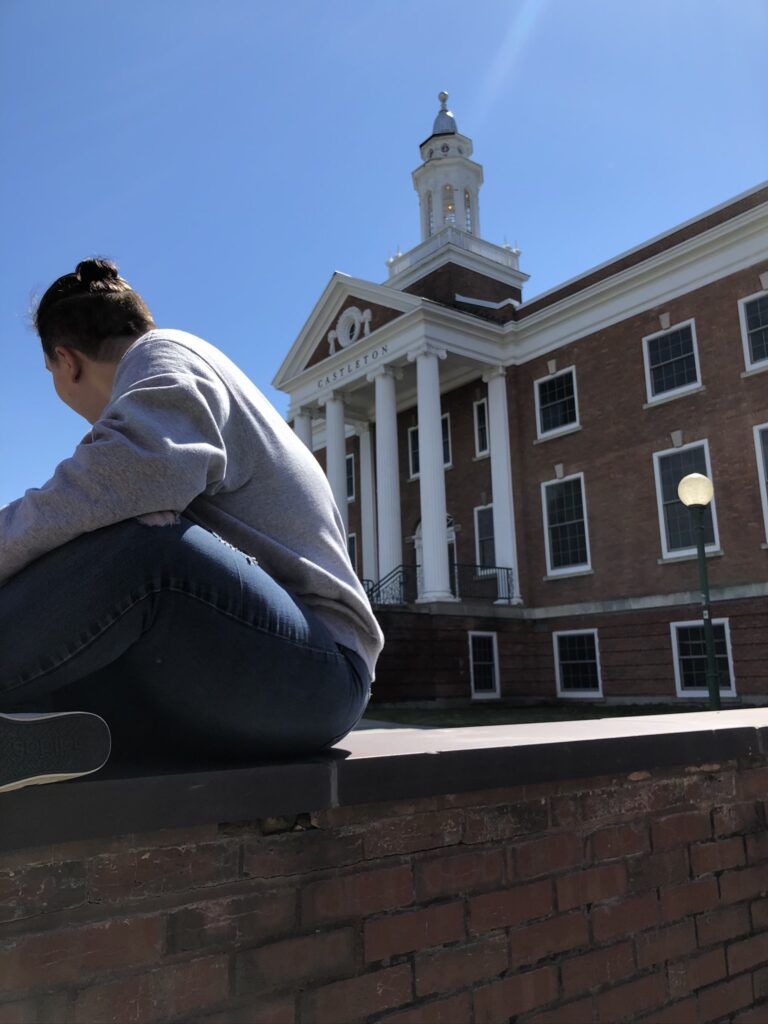Castleton faculty push back on merger demands, seek “pause”

Overwhelmed and confused Castleton University faculty have asked the Vermont State Colleges Board of Trustees to “press pause” on the controversial multi-school merger, in a letter sent to the board and Chancellor Sophie Zdatny on Oct. 26.
Concerned faculty members addressed grievances and hoped to appeal to the board that reconsideration of the proposed timeline of transformation events is necessary.
Information regarding the letter was leaked to a Castleton Spartan staff member shortly after the letter was sent, and the paper has since received a copy from another source.
The letter, which was developed in a special Faculty Assembly meeting on Oct. 19, has received over 50 professor signatures. Roughly two-thirds of Castleton faculty attended the meeting – an estimated 68 individuals – to discuss the faults and lack of supporting data for the rapidly progressing merger.
“It really came out of many, many weeks and maybe even months, of just not knowing what we could or should do, but knowing that something was off,” Professor Marybeth Lennox-Levins said. “This is a really big process for the VSC. And what we want to do is ensure that it’s done correctly so that when we’re done, we don’t do it again in five years.”
Lennox-Levins serves on the Executive Council of the Faculty Assembly alongside Faculty Assembly President and biology professor, Preston Garcia, who called the meeting at which the letter was drafted and unanimously approved.
Garcia said the major issues being brought forward by the group include a rushed timeline of events professors are being forced to adhere to, as well as the “backwardness of how things are progressing.”
The members of the Faculty Assembly also stressed they are not opposed to a merger, but rather hope the merger proceeds thoughtfully and with consideration to all parties.
“We are greatly concerned that the haste with which the transformation process is proceeding, with decisions being made in advance of data being collected and analyzed, will result in a system that will collapse. It is a building being constructed before the blueprints are finished,” the letter read.
Faculty fear further cuts
Faculty members echoed specific concerns over being tasked to streamline the New College Entity’s course offerings and determine the modality in which they will be delivered alongside faculty from Northern Vermont University and Vermont Technical College. An outside higher education consulting firm, rpk Group, has already provided the universities with a list of the most viable programs and the process of what is known as “Program Optimization” has been left to professors.
However, faculty feels they are not being allotted the appropriate amount of time to make these decisions as the May deadline swiftly approaches.
“We’ve already eliminated some programs here, including my own geology program. There’s no longer a geology major because we were told in an analysis last year that it was not sustainable,” professor Helen Mango said. “So, some of this work has been done, but basically, this optimization process is much bigger.”
Mango helped write the letter and said little progress has been made in adapting the more the 100 courses offered between just NVU and Castleton. Mango referenced that the recent revision of Castleton’s General Education program alone took over four years to complete.
Physical education professor Lisa Pleban reiterated Mango’s concerns and added that the time-bound demand has led to anxiety among faculty members and a feeling that departments across the separate campuses have been almost pitted against each other in determining whose courses survive the cuts.
“I worry about burnout amongst staff and faculty. We have anxiety over not knowing where this plan is going from one day to the next or, again, not really having a plan. So, depending on what your role is, as faculty or staff, the emotions were anywhere from ‘this might not have a big impact on me’ to ‘this might be awesome’ to ‘I just can’t take on this extra work and I’m afraid to lose my job,’” Pleban said.
When reached for comment on Friday, Zdatny said she intends to work through the concerns brought forward regarding the progression of the merger, and hopes to address them with Faculty Assembly leaders.
“[Divisiveness among campuses] was certainly something I heard, and I understand is a concern. We’re trying to explore ways in which we can address that so that faculty can work together and work out what the future programming will look like for the university,” she said.
Will insolvency be solved?
Other concerns raised in the letter include a lack of planning that has gone into the merger’s desired outcomes as well as a lack of evidence to prove these outcomes will be beneficial to faculty and staff, students, and stakeholders.
Some of the major selling points of the new university have been how the structure will be more inviting to prospective students, non-traditional and otherwise, who will have access to remote learning opportunities and cross campus course offerings. Professors say little to no data has been provided to prove this outcome will better the financial standing of the struggling colleges.
“For my program, students will need to take a few of their courses remotely, and we have no evidence that students are willing to do this. Preliminary data from the survey that the SGA (Student Government Association) has asked me to help with suggests that students come to Castleton because they want in-person learning and a small college experience. We do not want to jeopardize that,” political science professor Rich Clark said. “The SGA survey also shows that Castleton students are strongly opposed to the merger. The chancellor’s office needs to convince students that this is the right thing, since it is students who pay the bills, and to serve students is the only reason we exist.”
Vermont State legislation has also required the new university to reduce expenditures and save $25 million dollars over a 5-year period, which mirrors the reported $9 million dollars saved in the Lyndon-Johnson merger – data which has yet to be seen by faculty.
“We understand the legislature made [the financial] demand, which I don’t think was a sound demand, for institutions that have been not fully funded. Those are big decisions, and we’re not being told how those financial cuts are going to be achieved,” Garcia said.
The lack of physical evidence of explaining where and how NVU saved the large sum has professors also calling into question the legitimacy of these figures.
But Zdatny emphasized that these numbers are accurate.
“The $9 million came in a reduction in expenses at NVU,” she said when asked Friday. “A lot of that came from administrative personnel savings because they went from having two presidents and two provosts and two deans of students, etc, down to having one.”
When asked her reaction to the letter, Zdatny said that when she received it, she was happy to have already had a prescheduled meeting a couple days later with the Faculty Assembly Leaders and department chairs.
“I’m glad to have had the opportunity to go ahead and talk to them, you know, within a day or so of receiving the letter, so I can really hear and understand what their concerns were,” she said.
A Castleton Spartan staff member also learned from a source that the difference in dollars-per-student funding received from the state for Castleton University students was significantly lower than that of the other merging institutions.
Zdatny clarified that, historically, public community colleges and technical colleges in Vermont and other states are funded at a higher rate than traditional liberal arts colleges and that there’s a difference in how these funds get divided up between the types of schools.
“Different states handle this in different ways and the way it happens in Vermont is we are given a base appropriation and then the board determines how that base appropriation is going to be divided up,” Zdatny said. “Right now, the policy for dividing up and allocating the resources has been suspended because we are moving towards it being systemwide. So, that policy is one part of the pieces that are being worked on in part of the transformation process, in terms of what that will look like moving forward.”
During the Chancellor’s Town Hall Meeting held on Sept. 24, VSC’s Chief Financial Officer Sharron Scott said that the $25 million in savings would likely come from attrition—or professors and staff leaving due to retirement or other types of voluntary leave—and the streamlining of administration, specifically having only one president.
Many professors argue this figure is just not feasible.
But Zdatny explained that, though that was recommended by the State’s Legislative Select Committee regarding the transformation, there are other ways the system can obtain that $25 million dollars over a 5-year period. She said they do not anticipate gaining it fully through attrition.

Judging the numbers
Mango pointed out that another cause for faculty worry was that the vision and mission statement for the new university was only determined on Oct. 22 of this year, which faculty were not consulted on, and that the business plan for the future revenue of the university will not be released until the end of the year.
“We keep being told that the reason that we have to do this transformation and unify the system is because it was fiscally insolvent. And so that’s what’s rushing us forward. But we need to know what’s coming up. Where are the cuts? Where’s the revenue stream projections? Where are the cuts to administration at the central level?” Mango questioned. “We’ve already been cut across the system faculty and staff between 20% and 30%.”
The merger of Lyndon-Johnson, which has often been used as the stepping stone that marks the success of this type of transformation, was also called into question for the lack of information about where the $9 million dollars in savings came from and why Lyndon and Johnson are currently represented as separate entities on the Student Advisory Council.
“That’s part of the confusion about this merger. The merger that’s already been attempted has really not been fully implemented. And perhaps lessons should be learned from that. Let’s figure out things like governance and how governance on different campuses is going to be aligned to help move this transition forward,” Pleban said. “We don’t have a plan in place. We’re building the airplane as it’s flying.”
Anti-inconclusive, not anti-merger
Though faculty are deeply concerned about the progression of the merger in its current state, most if not all, want the transformation to be successful. Faculty hope to “press pause” on the process to ensure that every decision is serving the best interest of all those with a stake in the future of the three universities.
“Any institution or organization can be made more efficient. We just want the process carried out correctly and in a reasonable timeframe because we’re worried a rushed timeframe benefits no one and can lead to poor decision making and real harm to the institutions as they currently stand,” Garcia said.
Castleton University Provost Thomas Mauhs-Pugh acknowledged the merging of three institutions can be complex and difficult.
“Castleton faculty want to make sure it is done as well as possible, so they’ve asked for more time and more information. Because of the relationship between each step of the transformation plan and some important deadlines, it remains to be seen how flexible the timeline can be,” he said.
University President Jonathan Spiro was also reached for comment but thought it prudent to save his comments for a later time when the letter has been released to the public.
Above all, members of the Faculty Assembly hope that their concerns and the concerns of their students are understood and taken into consideration.
“I think the jury’s out on whether we were heard or not. Like anybody, I think the chancellor’s intentions are in the right place. I think she’s trying to manage a lot of stakeholders. Rightfully so, she couldn’t say ‘all right, I’m on my board. I want to help and change.’ Everybody needs time to really process the information, particularly the type of information we were asking for and giving her,” Lennox-Levins said. “We are working extremely hard to ensure that the product, at the end of the proverbial day, is as great if not better than it was.”
Zdatny said that she and her team are ready and available to help faculty work through the qualms addressed in the letter and that she, too, aims to create a better university.
“The letter was addressed to me so I’m doing this, because my responsibility is to really work with the faculty having heard what their concerns are, work with our chief academic officers and the other Faculty Assembly presidents to see what we can do to address the concerns that the faculty have raised,” Zdatny said.
Spartan Managing Editor Aris Sherwood contributed to this report.








